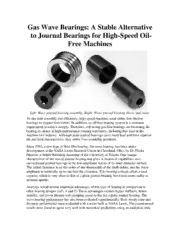
NASA Technical Reports Server (NTRS) 20050180239: Gas Wave Bearings: A Stable Alternative to Journal Bearings for High-Speed Oil-Free Machines PDF
Preview NASA Technical Reports Server (NTRS) 20050180239: Gas Wave Bearings: A Stable Alternative to Journal Bearings for High-Speed Oil-Free Machines
Gas Wave Bearings: A Stable Alternative to Journal Bearings for High-Speed Oil- Free Machines Left: Wave journal bearing assembly. Right: Wave journal bearing sleeve and rotor. To run both smoothly and efficiently, high-speed machines need stable, low-friction bearings to support their rotors. In addition, an oil-free bearing system is a common requirement in today's designs. Therefore, self-acting gas film bearings are becoming the bearing of choice in high-performance rotating machinery, including that used in the machine tool industry. Although plain journal bearings carry more load and have superior lift and land characteristics, they suffer from instability problems. Since 1992, a new type of fluid film bearing, the wave bearing, has been under development at the NASA Lewis Research Center in Cleveland, Ohio, by Dr. Florin Dimofte, a Senior Research Associate of the University of Toledo. One unique characteristic of the waved journal bearing that gives it improved capabilities over conventional journal bearings is the low-amplitude waves of its inner diameter surface. The radial clearance is on the order of one thousandth of the shaft radius, and the wave amplitude is nominally up to one-half the clearance. This bearing concept offers a load capacity which is very close to that of a plain journal bearing, but it runs more stably at nominal speeds. Analyses reveal several important advantages of this type of bearing in comparison to other bearing designs (refs. 1 and 2). These advantages include higher stiffness, better stability, and lower friction with damping equal to that for a plain journal bearing. The wave bearing performance has also been evaluated experimentally. Both steady-state and dynamic performance were evaluated with a tester built at NASA Lewis. The experimental results were found to agree very well with numerical predictions using an analytical code developed by Dr. Dimofte (refs. 3 to 6). This wave bearing technology can be successfully used in turbomachines, auxiliary power units, fans and air cycling machines, pumps (including blood pumps), high-precision spindles (such as those used in laser copy machines and computers), and machine tools. Since 1994 an effort has been underway with the Allison Engine Co. to install wave bearings in the auxiliary power units for a hybrid car. The bearing can be manufactured either as an integrated assembly ready to be installed inside the machine body (top figure) or as a two-piece assembly consisting of a sleeve and a rotor (bottom figure). The sleeve needs to be supported inside the machine body. Ceramic/ceramic or ceramic/steel materials have been used for the sleeve/rotor assembly. Furthermore, since 1995 several companies have become interested in this wave bearing technology, including Sundstrand, Teledyne, AlliedSignal Automotive and Aerospace Divisions, Hamilton Standard, and Pratt & Whitney. This advanced technology also has direct applications to NASA's aeronautical and space propulsion programs. References 1. Dimofte, F.: Wave Journal Bearing With Compressible Lubricant-Part I: The Wave Bearing Concept and a Comparison to the Plain Circular Bearing. STLE Tribol. Trans., vol. 38, no. 1, 1995, pp. 153-160. 2. Dimofte, F.: Wave Journal Bearing With Compressible Lubricant-Part II: A Comparison of the Wave Bearing With a Wave Groove Bearing and Lobe Bearing. STLE Tribol. Trans., vol. 38, no. 2, 1995, pp. 364-372. 3. Dimofte, F.; Addy, H.E.; and Walker, J.F.: Preliminary Experimental Results of a Three Wave Journal Air Bearing. Advanced Earth-to-Orbit Propulsion Technology 1994, NASA CP-3282, vol. II, 1994, pp. 375-384. 4. Dimofte, F.; and Hendricks, R.C.: Fractional Whirl Motion in Wave Journal Bearings. Seals Code Development Workshop, NASA CP-10181, 1995, pp. 337- 352. 5. Dimofte, F.; and Hendricks, R.C.: Two- and Three-Wave Journal Bearing Fractional Whirl Motion. Proceedings of the Society of Engineering Science 32nd Annual Technical Meeting held in New Orleans, LA, Oct. 29-Nov. 2, 1995, pp. 773-774. 6. Dimofte, F.; and Hendricks, R.C.: Three-Wave Gas Bearing Behavior with Shaft Runout. Proceedings of the Eighth Workshop on Rotordynamic Instability Problems in High-Performance Turbomachinery held at the Texas A&M University, College Station, TX, on May 6-8, 1996, pp. 5-13. Lewis contacts: Dr. Florin Dimofte, (216) 977-7468, [email protected]; and Robert C. Hendricks, (216) 977-7507, [email protected] Author: Dr. Florin Dimofte Headquarters program office: OAST
